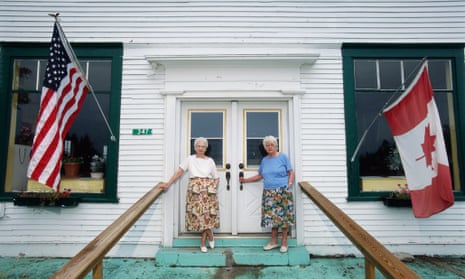If you’re a proud member of America’s middle class, you may have been startled to learn last week that your after-tax income now makes you worse off than your Canadian neighbors to the north. They can now claim the title of the richest middle class on the planet.
Let’s take a look at the bombshell that the New York Times dropped in our midst last week. It’s based on data from the Luxembourg Income Study Database, and focuses squarely on median income.
That means that instead of being distorted by the impact of millionaires and billionaires becoming still richer and the wealth gap becoming still wider, using this data gives analysts a sense of the experience of the average household in any given country. It also means an economist can compare overall economic growth of a country to the experience of individual households in that country – and by those standards, the United States just doesn’t come off that well.
Because while our economy has been growing more rapidly than those of other nations, a smaller percentage of those households is sharing in that prosperity, the data suggests. (Income inequality is at its highest level since 1928.)
Median after-tax income for a family of four in both Canada and the United States hit $75,000 in 2010 and as later income surveys show that Canadians have earned larger wage gains than their counterparts south of the border in the years since then, Canadian income now is ahead of that in the US. The gap is even wider further down the wealth ladder.
Why? Education levels may still be high among those of us over 50, but younger Americans aren’t as competitive. Then there’s the fact that employees get a smaller share of corporate pie than do executives: CEOs are paid more; the minimum wage is lower. That has left American incomes flatlining – and in contrast to European nations and Canada, the government plays very little role in redistributing income.
I confess that the suspicion that this might be the case has been sneaking up on me for some time. It has been exactly 20 years this month since I left Toronto to live in New York. And being able to compare and contrast the two systems made me think about them both more critically.
I started doing this when friends began worrying about how to save for their child’s college education. Why were they so worried? Attending Queen’s University – one of Canada’s best and certainly its most pricey – the most I had ever paid for a year’s tuition was $1,100, so I had graduated free of debt.
I looked at US tuition levels, realized that my friends were still paying off their own loans, and started to wonder why the middle class in the US is struggling under such a tremendous burden. If university is affordable for those who are able to win a place – without bankrupting their parents or encumbering them with a mountain of debt – then that’s two generations of the same family who are going to be better off.
Canada seems to realize this: that’s why the government subsidizes the vast majority of the tuition tab. Today, if a Canadian teenager gets into Queen’s, McGill or Dalhousie, or one of any number top universities, their tuition will still set them back only $6,500 a year or so. Princeton, analogous in status to Queen’s or McGill? Next year’s tuition bill will be $40,170.
Then there’s Canada’s healthcare system. (Remember, the LIS analysis is of after-tax income, and the bill for those education and health benefits are paid from taxes.)
Yes, the state single-payer system (administered through the provinces) means that in some regions and for some kinds of care, pockets of scarcity can emerge. If you want an MRI tomorrow, odds are that isn’t going to happen, unless it’s a medical emergency.
On the plus side, when your turn comes, you won’t be billed for it.
Having lots of elderly relatives dealing with everything from cancer to hip replacements (and with relatives working as physicians), I can say I don’t know anyone who’d swap what they have for what we have. I’ve asked.
“Are you nuts?” one great-aunt asked me at a family reunion a few years ago. “You’ve lived there too long.”
True, Canadians still have to fork over for other stuff: dental care, vision care, prescriptions. But when Canadians buy prescription drugs, they’re still paying less than Americans are. Again, that’s because the government takes an active role in the market, capping how much pharmacies legally can pay to purchase medications. (My migraine medication, had I been able to buy it in Canada, would have cost me less than a third of the lowest price I’ve found at a US pharmacy, the last time I checked.) That’s why the FDA cracked down on online sales by Canadian pharmacies a decade ago.
Those are two big-ticket items about which most Canadians have to worry much, much less than their American cousins south of the border. Today, they also have to worry less about a third item: mortgage costs. (Here it’s harder to compare apples to apples, since Canadian banks don’t offer 25-year mortgage loans). A five-year adjustable rate mortgage in the US has an average rate of 3.34%, according to Bankrate.com; in Canada, you could get a similar loan for 2.3%.
Of course it’s not all roses.
The more you like to spend on day-to-day stuff, the more you’ll feel that you’re not really all that much better off north of the border.
Feel like catching a showing of Captain America: The Winter Soldier? In Toronto, that will set you back more than $18 each, compared to $14 in New York (and $10.50 in Providence, where I live now.)
Want to buy a copy of the new thriller by Greg Iles, Natchez Burning? The list price in Canada is a whopping $31.74 (in US dollars), compared to $27.99 in the United States. (Even the discounted price is higher than the comparable discounts available to US readers.)
And then there are the taxes. Buy a new pair of shoes in Ontario, and brace yourself for a 13% federal and provincial sales tax atop the (already higher) price.
But a new pair of shoes or a movie ticket isn’t going to be what makes or breaks a financial plan, or boots us, or our children, out of the middle class altogether. It’s going to be the cost of healthcare, or the lack of a college education.
In the United States, individual members of the middle class have seen their after tax take-home pay flatline but still must shoulder the burden for those expenses, which have risen at rates far exceeding the rate of inflation. In Canada, not only is the middle class now better off after paying its taxes, but it is free of a large part of that burden altogether. Now, that’s food for thought – and debate.





Comments (…)
Sign in or create your Guardian account to join the discussion